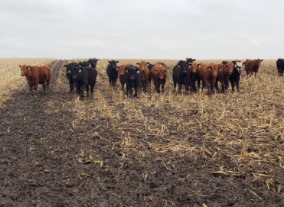Little corn residue remains after concentrated grazing in the high stocking density treatment the day that cattle were moved from the fields in March of 2020.
The researchers studied corn fields in Nebraska, where around half of the corn fields are grazed after harvest. The team measured various soil properties that contribute to compaction and the yield of the soybeans planted in the fields the following season after cattle were done grazing. The team repeated the experiment over two years.
“Much like previous fall grazing studies, minimal effects were seen on soil properties and yield due to spring grazing, regardless of the number of cattle and area grazed,” says Grabau.
The soybean productivity of the fields following grazing did show some changes. The highly concentrated grazing for just 15 days actually increased yields slightly.
“This yield increase could be due to more residue removed, causing warmer soil temperatures for plants to grow,” Grabau says.
The cattle did cause some soil compaction. But their effects were limited to the surface level of fields.
“Compaction isn’t permanent,” Grabau says. “Soil can loosen up again as it dries and saturates over and over, and microbial activity in the soil also reduces compaction.”

The high stocking density treatment had 24 cattle grazing corn fields for 15 days. This treatment increased future soybean yields slightly, perhaps because removing the corn residue warmed the soil.
Fortunately, soybean seedlings had no problem establishing themselves in the soil after grazing even with some surface compaction present.
“Even when we created a worst-case scenario, grazing in the spring when the ground was wet, compaction was minimal and subsequent soybean yields were not negatively affected,” Grabau says.
Although Grabau says that fall and winter grazing is probably still the best solution, farmers shouldn’t be afraid of grazing cattle in the spring.
“The integration of crops and livestock is a beneficial production system,” says Grabau. “Grazing cattle on corn residue can be a great way to make even more food for human consumption from corn fields, as both the corn grain and plant residue can be used as feed for livestock.”
Morgan Grabau is a graduate student in animal science at the University of Nebraska-Lincoln. This project is supported by the Nebraska Agricultural Experiment Station with funding from the Hatch Multistate Research Program of the United States Department of Agriculture National Institute of Food and Agriculture.
Click here to see more...